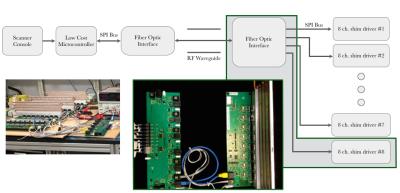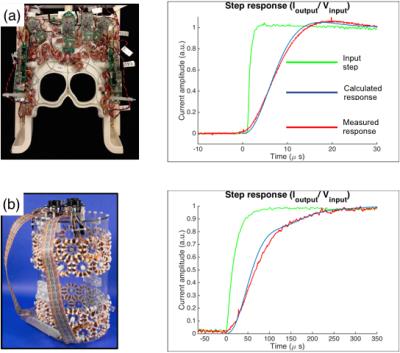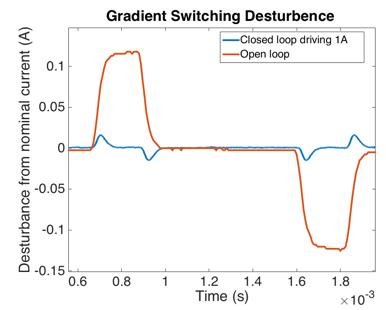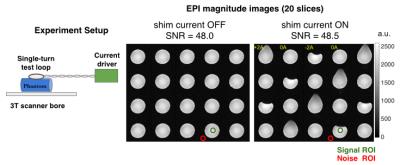2682
Open-Source Acquisition-speed slice-by-slice controller for 32 coil B0 shimming.1Electrical Engineering and Computer Science, Massachusetts Institute of Technology, Cambridge, MA, United States, 2A. A. Martinos Center for Biomedical Imaging, Massachusetts General Hospital, Charlestown, MA, 3Harvard Medical School, Boston, MA
Synopsis
Accurate B0 shimming with close-fitting coil arrays can improve brain imaging at 3T and 7T, but slice-optimizing the shimming during acquisition requires fast redistribution of dozens of multi-amp coil currents. Our open-source, low-cost ($80/channel) driver system can redistribute fifty amps to thirty-two coils in milliseconds, with milliamp accuracy. The system uses an easily reprogrammed microcontroller, optical fiber isolation, and thirty-two current-feedback coil-drivers (described previously). When used to drive sixty-four slice-specific sets of currents in a novel 32-coil shim array, stretching in an EPI brain scan was substantially reduced, without introducing driver artifacts.
Design
The digital interface for an eight channel Open-source, low-cost, flexible, current feedback-controlled driver boards[3] was improved for better MR compatibility and ease of use. Digital signals driven from a low cost micro controller set currents and give feedback over a Serial Peripheral Interface (SPI). These signals are transmitted from outside outside of the magnet room using a fiber optic interface. By separating the digital control from current driver boards, the drivers can be placed inside of a magnet room without causing RF interference. High speed SPI signals received over fiber are distributed to up to 8 current source boards, each with 8 +/- 5A channels over differential pairs on CAT5 cable. Differential signaling prevents digital switching from creating RF nose. The differential signals are more robust to interference from RF pulses and gradient slew. Less sensitive lower speed signals are single ended. Optical isolation of the digital signals on each current driver board prevents ground lift from disrupting communication. Analog to digital converters (ADC) on the current driver board allow for monitoring of all output currents and the use of digital feedback to improve accuracy. To ensure correct synchronization of ADC data for arbitrary cable lengths, fiberoptic latencies, and bit-rates, a synchronizing clock is sent with the return data.Performance
Feedback compensation is adjusted for the load impedance to optimize the stability and rise time. The local coil multi-coil shim system is capable of 10µS output current rise times when driving 10µH loads and rise times of 200µS when driving 670µH loads (Figure 2). This range of loads is representative of local multi-coil shim arrays [1,2]. Output currents remain stable during RF pulses and gradient slewing. Analog feedback reduces the disturbance due to gradient slew (Figure 3). At low usage duty ratio while driving maximum current from all channels, passive cooling is sufficient. For continuous use, active cooling is necessary for correct operation. Power output failure modes are benign and result in shim shutoff. The current driving system operates in the magnet room without introducing RF artifacts. By disabling communication during readout, the the digital system had no impact on SNR performance. Shim currents can be adjusted between slices without RF artifacts enabling dynamic shimming. A single turn test loop was driven by one channel from an channel shim driver board. A TTL pulse from the MR console triggered toggling shim currents. No distortion appeared on un-shimmed slices and SNR was unaffected by dynamic shimming (Figure 4).Applications
7T local B0 shim array
An ensemble of 4 current source boards was used for 32 channel in vivo local multi coil shimming. Current output of each channel was limited to three amps and a total current across all channels was limited to 50A by the power supply. Field maps of each coil as driven by a reference current from the shim driver system were measured. The slice optimized shim for a single slice was maintained for the duration of the scan. The field map of the resulting slice had high agreement with simulation, indicating accurate, reproducible currents. Distortion in EPI images was reduced. Shimming did not increase SNR or introduce structured artifacts.
Educational MRI GPA
Open source hardware reduces non-recoverable engineering time when designing new equipment. The power output stage of the 8 channel current driver board was used in the design of a three channel gradient power amplifier for tabletop MRI machines [4]. Design and validation time was reduced through schematic and layout reuse. Reuse and re-validation of the design buffets the certainty of its reliability.
Discussion
Developing low-cost systems that can rapidly and accurately redistribute large currents to dozens of individual coils is an daunting engineering task, requiring a combination of careful system architecture, judicious use of commodity hardware, and clever circuit design. By offering our design in an open source manner (https://rflab.martinos.org/index.php/Current_driver:Current_driver) we hope to eliminate this barrier to innovation in many-coil systems for imaging.Acknowledgements
We acknowledge the following funding sources:
Skoltech University
NIH K99 EB021349
References
[1] Juchem C, et al., JMR 2010.
[2] Stockmann JP, et al., ISMRM 2016, p. 1153.
[3] Arango N, et al., ISMRM 2016, p. 1157.
[4] Cooley C, et al., ISMRM 2014, p. 4819.
Figures




